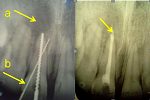Combined endoperiodontal injury secondary to trauma incisal
Keywords:
endodontic pathology, periodontal disease, occlusion, X-ray.Abstract
Introduction: in dental practice, it is common to find clinical situations in which, in a cursory examination, it is not clear whether this is an endodontic, periodontal or a combination of both affections, so that the classification of these lesions is performed in relation to the primary source of origin which may be pulp or periapical and from these structures affect the tooth as a whole; spreading the infection process, even the bony ridges. There are no marked difference in age groups and sex.
Objectives: the aim of this paper is to present a case of combined endoperiodontal injury secondary to incisal trauma and the importance of radiography for diagnosis.
Facts of the case: female patient with a history of previous health comes having pain and enlargement of deep red upper central incisor region, radiographically injury involving the apical thirds of central and lateral incisors appear, showing vitality in this one. It was treated by the emergency service by cameral access.
Main comments: It was necessary in a variety of both clinical examination and diagnostic tests for differentiating between true endodontic and periodontal lesions. The definitive diagnosis could only be established on the basis of clinical and radiographic findings. Combined periodontal and endodontic treatment was performed with a good prognosis.
Downloads

Published
How to Cite
Issue
Section
License
Authors retain all rights to their works, which they can reproduce and distribute as long as they cite the primary source of publication.
The Rev Cubana Estomatol is subject to the Creative Commons Attribution-Non-Commercial 4.0 International License (CC BY-NC 4.0) and follows the publication model of SciELO Publishing Schema (SciELO PS) for publication in XML format.
You are free to:
- Share — copy and redistribute the material in any medium or format.
- Adapt — remix, transform, and build upon the material.
The licensor cannot revoke these freedoms as long as you follow the license terms.
Under the following terms:
Attribution — You must give appropriate credit, provide a link to the license, and indicate if changes were made. You may do so in any reasonable manner, but not in any way that suggests the licensor endorses you or your use.
- NonCommercial — You may not use the material for commercial purposes.
No additional restrictions — You may not apply legal terms or technological measures that legally restrict others from doing anything the license permits.
Notices:
- You do not have to comply with the license for elements of the material in the public domain or where your use is permitted by an applicable exception or limitation.
- No warranties are given. The license may not give you all of the permissions necessary for your intended use. For example, other rights such as publicity, privacy, or moral rights may limit how you use the material.

